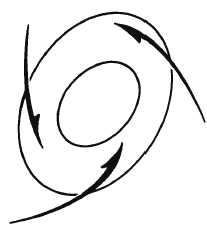The formation of an anticyclone or the
intensification
of
an
existing
one
is
called
anticyclogenesis. Anticyclogenesis refers to the
development of anticyclonic circulation as well as the
intensification of an existing anticyclonic flow. When a
high-pressure center is increasing in pressure, the high
is BUILDING or INTENSIFYING. Although a high
can build (or intensify) without an increase in
anticyclonic flow, it is rare. Normally, building and
anticyclogenesis occur simultaneously. The weakening
of anticyclonic circulation is anticyclolysis. When the
pressure of a high is decreasing, we say the high is
weakening. Anticyclolysis and weakening can occur
separately, but usually occur together.
The vertical extent of pressure greatly depends on
the air temperature. Since density increases with a
decrease in temperature, pressure decreases more
rapidly vertically in colder air than in warmer air. In a
cold anticyclone (such as the Siberian high), the
vertical extent is shallow; while in a warm anticyclone
(such as the subtropical high), the vertical extent
reaches high into the upper atmosphere due to the slow
decrease in temperature with elevation.
Cyclones
A cyclone (low) is a circular or nearly circular area
of low pressure with a counterclockwise flow. The flow
is slightly across the isobars toward the center in the
Northern Hemisphere and clockwise in the Southern
Hemisphere. (See fig. 3-16.) It is commonly called a
low or a depression. This use of the word cyclone
should be distinguished from the colloquial use of the
word as applied to the tornado or tropical cyclone
(hurricane).
The
formation
of
a
new
cyclone
or
the
intensification of the cyclonic flow in an existing one is
called cyclogenesis. When the pressure in the low is
falling, we say the low is deepening. Cyclogenesis and
deepening can also occur separately, but usually occur
at the same time. The decrease or eventual dissipation
of a cyclonic flow is called cyclolysis. When the
pressure in a low is rising, we say the low is filling.
Cyclolysis and filling usually occur simultaneously.
Cyclones in middle and high latitudes are referred to as
extratropical cyclones. The term tropical cyclone refers
to hurricanes and typhoons.
VERTICAL STRUCTURE OF SECONDARY
CIRCULATIONS (PRESSURE CENTERS)
To better understand the nature of the pressure
centers of the secondary circulation, it is necessary to
consider them from a three-dimensional standpoint.
With the aid of surface and upper air charts, you will be
able to see the three dimensions of these pressure
systems as well as the circulation patterns of the
secondary circulation as established at higher levels in
the troposphere and lower stratosphere.
In Chapter 2, the study of gas laws showed that
volume is directly proportional to temperature. Stated
another way, we might say that the thickness of a layer
between two isobaric surfaces is directly proportional
to the mean virtual temperature of the layer. Because
the atmosphere is always moist to some degree, virtual
temperature is used. Mean virtual temperature is
defined as the average temperature at which dry air
would have the same pressure and density as moist air.
Thus, lines representing thickness are also isotherms of
mean virtual temperature. The higher the mean virtual
temperature, the thicker the layer, or vice versa. The
thickness between layers is expressed in geopotential
meters. The shift in location, as well as the change of
shape and intensity upward of atmospheric pressure
systems, is dependent on the temperature distribution.
An example of the effects of virtual temperature
can be demonstrated by placing two columns of air next
to each other. One air column is cold and the other air
column is warm. The constant pressure surfaces in the
3-17
LOW
CYCLONIC
CIRCULATION
AG5f0316
Figure 3-16.—Cyclone.



